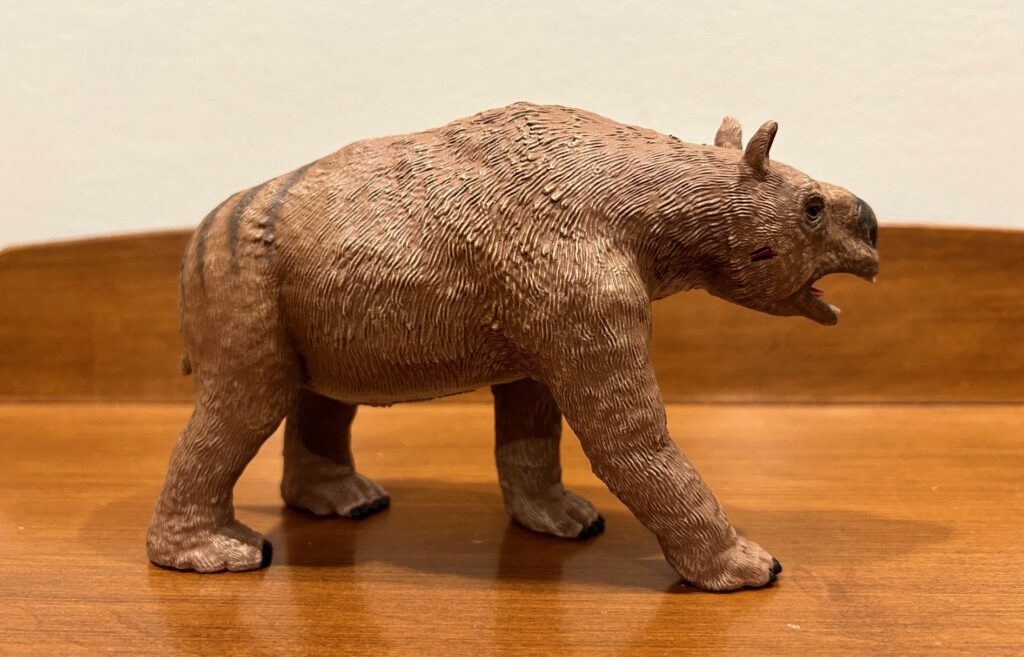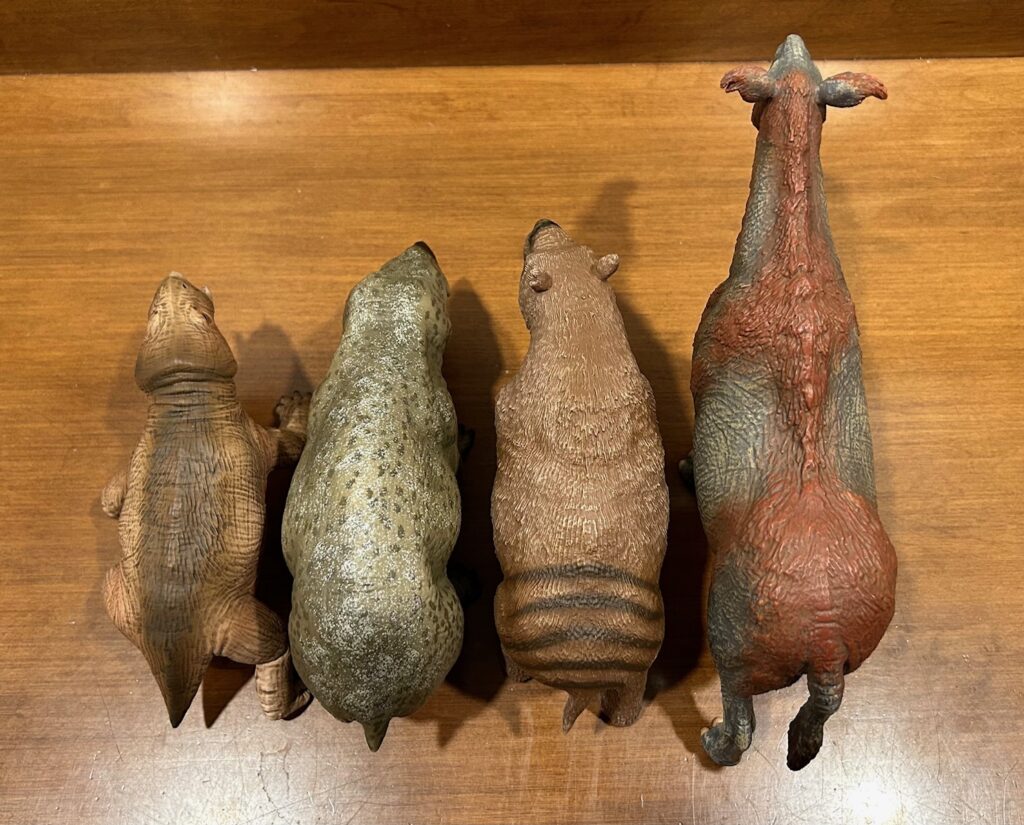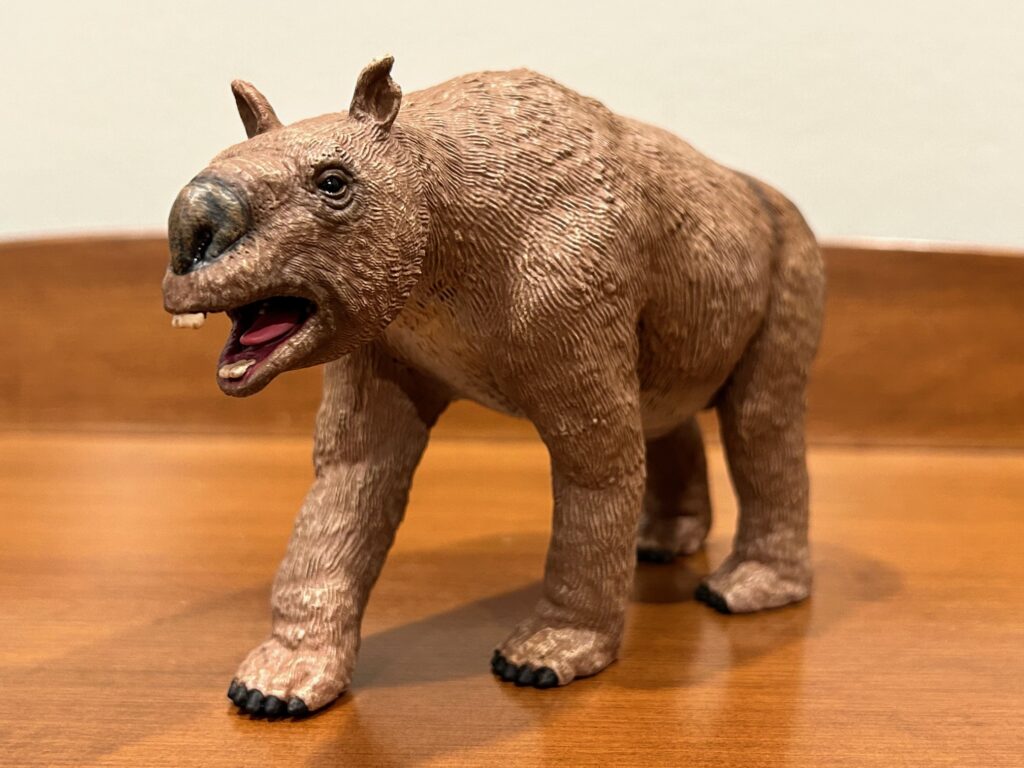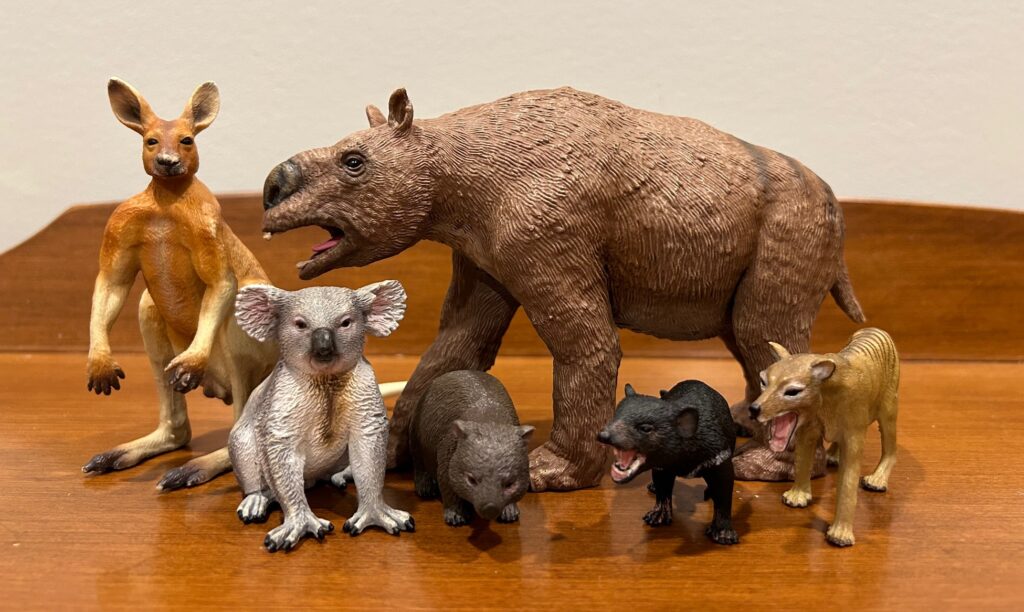
The very first Australian prehistoric mammal to be named and described (by Sir Richard Owen back in 1838), Diprotodon is by far the biggest marsupial that we know of. A mature male would have been over 4 metres long, 1.8 metres tall at the shoulders, and weighed at least 2800 kg, which is heavier than a male hippopotamus and rivalling a male white rhinoceros. Females would have been considerably smaller. Diprotodon lived during the Pleistocene from 1.77 million to only about 40,000 years ago, and would have been encountered and perhaps even hunted by Aboriginal Australians.


Diprotodon is this year’s extinct mammal from CollectA. This is not the very first toy of the species, but it is certainly the biggest. It measures a good 17.5 cm long from its incisors to its tail tip, stands slightly over 11 cm tall at the shoulders, and is 6 cm wide at the ribcage. And being made of solid PVC, it’s by far the heaviest out of CollectA’s entire 2024 prehistoric assortment, weighing in at a staggering 450 g. The latest in a number of toys that you would most assuredly hate to accidentally drop on your foot!


A glimpse between this individual’s hind limbs leaves no doubt that he is a male. He is posed in a walking stance with his right front leg extended forward, his head turned slightly to the left, and his mouth open. He could be squealing menacingly at a predator or a rival, or he could simply be yawning, panting, grazing, or perhaps grunting at a prospective mate.

Our male’s fur is coloured medium brown with light brown wash and very pale grey on the underbelly. The claws are black, the nose is black with brown wash applied to give it a mottled appearance, and the eyes and nostrils are glossy black. The inside of the mouth is maroon with a pink tongue and beige dentition. Topping it off are the five dark brown stripes on the rump and a blood red injury on the right cheek, which I’ll discuss in detail further on.

The result is a colour scheme that is considerably plainer than that of the Diprotodon from Southlands Replicas (now defunct, alas), but arguably more plausible. On that note, let’s compare the two toys now, shall we? The smaller SR toy was billed as a female, whereas CollectA’s is plainly a male. In addition to gender, size, and coloration, there are noticeable differences in the shape of the noses and the ears. Such is the speculative nature of paleoart.



When it comes down to it, I do believe firmly that the CollectA version has the superior sculpting detail of the two (but it’s a close race). The fur covering the entirely of the body is wonderfully sculpted all over, particularly on the head where it is smaller and finer. It appears to be of medium length, thicker than that of say, the Moropus, but certainly not as shaggy as the Elasmotherium.


The limbs are long and robust and the paws are quite large with five digits and thick pads on the soles. The digits on the front paws all bear short, blunted claws, while the short innermost digits on the hind paws lack them. The hind paws are also correctly turned inward; good on the sculptor for taking note of that feature. The tail is short, but still considerably longer than that of one of Diprotodon’s closest living relatives, the wombat. The koala is its other closest living relative, but it has no visible tail at all.

It must also be noted that this Diprotodon bears a healed battle scar on its left thigh in the form of five claw marks. The configuration of these marks leaves no doubt as to the perpetrator: Thylacoleo, AKA the marsupial lion, Australia’s top mammalian predator during the Pleistocene. CollectA has not yet made a toy of that ferocious beast, but for now, the Southlands Replicas version will do perfectly. Other potential predators of Diprotodon would have been the mekosuchine crocodilian Quinkana and the gargantuan monitor lizard Varanus priscus, AKA Megalania, which also have not been done by CollectA. Yet.

Turning now to the head, we can observe an enormous nose and a mouth equipped with prominent incisors that give this animal quite the gubbertushed grin. You can also easily discern the molars much further back in the mouth. Diprotodon is known to have possessed a particularly powerful bite force, perhaps comparable to that of an American alligator. This enabled it to feed on a wide variety of tough plant matter. One 53,000 year old specimen was found to have the remains of leaves, stalks, and twigs in its stomach cavity. Grass was also likely a mainstay of its diet.


As I mentioned earlier, there is an injury visible on our Diprotodon’s right cheek has been injured, and unlike with the claw marks on its thigh, it looks relatively fresh. Two deep gashes that seem to have been caused by a set of very large incisors. As well, there is a large chunk missing from the tip of this chap’s left ear. The most likely conclusion is that he’s recently had a fight with a fellow male Diprotodon, or bung on a blue to use an Australian phrase. Perhaps it over the right to mate, or maybe it was over a food source. Regardless of the reason, all these injuries add an extra touch of realism and character to this toy. He’s a tough ol’ bloke, he is!

When it comes to prehistoric mammals, I reckon nobody can top CollectA, and the Deluxe Diprotodon is solid proof of that. This is a truly bonzer toy all around, the best representation of the species to date and probably as close to accurate as one can possibly get without some means of time travel. And given those scars on the thigh, don’t be surprised if CollectA reveals a Thylacoleo for 2025. The colossal kangaroo Procoptodon or the totally tubular turtle Ninjemys would also be very much appreciated. In the meantime, I must again extend my deepest gratitude to CollectA for this review sample!

Support the Dinosaur Toy Blog by making dino-purchases through these links to Ebay and Amazon. Disclaimer: links to Ebay.com and Amazon.com on the Dinosaur Toy Blog are often affiliate links, when you make purchases through these links we may make a commission
Trending Products











